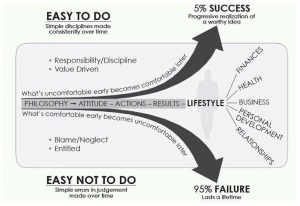- Anti-Racism Tip #8: If It Needs a Disclaimer, Don’t Say It - October 18, 2022
- On Tender Moments that Take Us By Surprise - May 18, 2022
- Finding Creative Ways to Exercise During the Pandemic - April 29, 2022
Have you ever found a book that really resonates with you? Through a series of serendipitous events, I happened upon a great book that seemed to be written just for me: The Slight Edge by Jeff Olson.
In the book, Jeff Olson talks about the way in which successful people become successful. He asserts that one person is no different from another and that anyone can become successful. In his view, the difference between those who become successful and those who don’t, however, is that successful people practice simple disciplines persistently and consistently over time that lead them along the path to success.
I thought it would be a good time of year to share some of the lessons that Jeff Olson shared in this book, since this philosophy can help all of us who have made commitments to tackle new things at the beginning of the year and it’s often around this time that our will power can start to waver!
Jeff Olson clarifies that successful people make decisions on a day-to-day and moment-to-moment basis that get them closer to or farther from success.
So, for example, people who get in good shape make decisions each day that can either help them get closer or farther from their goal. When faced with the choice of having a burger and fries for dinner or a hearty salad, for example, people who practice simple disciplines (by choosing the salad) will get closer to achieving their goal with each little decision they make. Similarly, people who religiously adhere to a workout schedule will get closer and closer to their goal of getting shape as compared to those who don’t.
Now, I know what you’re thinking… seriously, is this the major insight, Kirsten? I’ve heard all of this before. Well…this is where it gets really good…
What Jeff Olson points out is that these small decisions don’t seem to make a difference in the short term; there is no immediate harm. So if you do choose to eat a burger and fries one time or skip one workout, you are not going to see an immediate impact.
The thing is though, that these small decisions (or simple disciplines) have a compounding effect.
These things, as Jeff Olson points out, are easy to do and just as easy not to do; it’s easy to choose a salad over a burger and fries but it’s just as easy not to. People who are successful, however, are people who consistently and persistently practice these simple disciplines that move them in a positive direction towards their goals.
My Ah-Ha Moment
When I read this book, I realized that my ability to practice simple disciplines persistently and consistently over time, is exactly how I’ve been able to excel in sports, in academics and in my career.
The reason that The Slight Edge resonated with me so deeply is that Jeff Olson’s philosophy exactly describes the disciplined life of an elite athlete.
As a volleyball player aiming to become world class, I worked out three to five days per week, practiced for at least two hours per day, five days per week and competed in weekly matches or tournaments. This was my schedule and I didn’t deviate from it (except for our one month mandated rest period per year). Because of my priorities and the way I had been taught (by my amazing coaches) and chosen to design my life, the simple disciplines were built into my routine so it was inevitable that I would achieve success.
When it comes to real life, we have more choices in how we design our lives (and for those of us who were once athletes, we no longer have those coaches telling us when to practice and when to rest). We can choose to watch a lot of television; we can choose to stay up late; we can choose to eat junk food.
Without a clear direction or goal in mind, it becomes difficult to figure out what simple disciplines we should practice.
Which Curve Are You On?
One final thought from The Slight Edge…Jeff Olson notes that each person at any moment is either travelling on a path towards success or away from it. This graphic, excerpted from his book, usefully illustrates this idea:
By practicing simple disciplines persistently and consistently over time, we can achieve goals in various areas of our lives – and in doing so, we’ll continue to travel on the upward curve of success.
We do need, however, to figure out what our goals are in various areas of our lives to help us make decisions that support success in those areas.
So let’s figure out where we’re headed, shall we?
In a previous post, I described the importance of positive self-talk and controlling your thoughts. Now that you’re being nicer to yourself, you can start to identify the direction you want to go (your goal) and then start moving towards that goal using simple disciplines that you practice consistently and persistently over time. The goal can be related to your relationships, your health, your career, your finances or your passions outside work.
Example #1: Tackling My Lifelong Struggle to Keep My Closet Clean…
Let me illustrate by using an example from my life. I’ve always had a very messy closet.
A few years ago, I decided that I would like to clean up my closet and keep it clean for good. I started by putting all my clothes away. I realized, however, that part of the reason I was having trouble keeping my closet clean was that I had too many clothes. They wouldn’t physically fit into my closet.
So then I purged… I gave away three big garbage bags of clothing and then I was able to easily fit the rest of the clothes into my closet.
The next step for me to be successful was to make a new practice of putting my clothes away as soon as they were folded (for clean laundry) and as soon as I took them off when changing. I needed to create a new system or set of rules for myself in order to maintain the cleanliness of my closet.
The hardest part for me was actually in making this a priority.
Usually I’m so busy for every moment of my day – whether I’m working, or catching up with friends, or spending time with my kids, working on an academic article or writing a blog post that by the time I go up to bed, I just want to change as quickly as possible and go to sleep (oh and did I also mention that I like to get at least eight hours of sleep per night?).
So even though it would only take an extra moment to put the clothes away instead of throwing them into a pile on the floor, I had to make keeping my closet clean a priority in my own mind to practice the simple discipline of putting away my clothes.
For about three months, reducing the amount of clothes to physically fit into my closet worked. I soon realized that not having the right set-up made it difficult for me to be successful. My closet has a lot of open cubbyholes and it was only when I asked Robby to get me bins for each cubbyhole that I was actually able to be successful over the long term.
(If you know Robby, you know his superpower is organizing and keeping things tidy so when I asked him to do this he measured each cubbyhole (which are not all the same size) and got exactly what I needed for each one.)
I can happily report that my closet is clean on a consistent basis! (To all you neat freaks out there – including you, Robby – it may not always be up to your high standards but I’m pretty happy with it and for me this is huge!)
Even though I have kept it clean so far, I still know that I have to keep practicing the simple disciplines persistently and consistently over time to keep my closet clean. Oh and every time I see my clean closet, I give Jeff Olson a wink!
Oh and the best thing is that I just did this with my super duper messy office and here’s the before and after photo:

I followed the same steps: (1) I made it a priority to clean my office; (2) I got rid of three huge bins of papers I don’t need; (3) I got furniture to suit my needs and store away my remaining stuff; and (4) I made a commitment and created a system to keep it clean.
(I also declared it a no junk dumping zone for my kids and so far so good!)
Example #2: Starting and Maintaining a Blog
A few years ago, I discovered The Smart Passive Income Podcast by Pat Flynn. He talks about online marketing and really inspired me to start doing some things online. Since I started listening to his podcast I started using Facebook, I started a blog and I’m now exploring various methods of online marketing. This is a huge new challenge for me to undertake since I have never really made online platforms a priority so it’s a steep learning curve and… I have had to tackle some self-doubt about my ability to work with technology.
Once I decided to create a blog, however, I really needed to learn what steps I needed to actually bring it into being. Not only did I need to teach myself to use the backend of WordPress to create the blog posts and manage my website, I also needed to implement a system so I could create a blog post each week to publish online.
So the first thing I did was decide that I was going to create this blog, commit to doing it and prioritize its importance. Many blogs die out soon after they start because it requires people to re-prioritize their time and maintain the discipline to make sure that new content is posted on a regular schedule.
The second thing I had to do is start being kinder to myself through my thoughts and self-talk about my ability to tackle technology. I needed to actually change my thinking around my technological ability and reframe it as just another new skill that I am able to learn just like anyone else.
The third thing I had to do was actually figure out what to call my blog and the mechanics of setting it up so I listened to a whole bunch of podcasts, watched a ton of YouTube videos and had many discussions with customer support people who helped me out.
Finally, I had to create a system to create content to post on a weekly basis. I started a note on my IPhone with blog post ideas and I just jumped in the next week. My system initially was that on Monday nights I would sit down and write a blog post for posting the following day. When I finish my draft post, I would send it to my sisters Rachel and Naomi who would review it and provide constructive feedback (luckily they live in a different timezone so while I’m sleeping they can review it!). I then get up earlier than usual on Tuesday mornings to make any revisions and post it before going to work.
So now that I’ve created a weekly schedule to get the content out, I know that as long as I can set aside the time on Monday nights or on the weekend to get my blog post done, I’ll continue to meet my weekly publishing schedule.
So that worked at first…
But then a little wrinkle appeared… I have a bunch of other writing commitments (both academic and personal – did I tell you I am writing my first young adult novel right now?) that I need to diligently and consistently work on to get done to meet my deadlines. If I don’t prioritize each one of them as my big project for a consistent period of time I won’t get them all done. So I realized that I couldn’t realistically commit every single Monday night to writing a blogpost.
Although cloning myself probably is the best scenario to managing all my off-the-wall side projects and the limited time I have to pursue them, I came up with another creative solution. I asked my two amazing sisters if they would start a new blog with me so we could split the content creation time three ways! Since we have always talked about having some kind of family business and we are super glommers who love spending time together, this has been an amazing next step!
So here we are…
The thing I want to highlight about both examples is that my first attempt to tackle these big goals wasn’t perfectly designed from the outset. This is one of the hardest and most important lessons that I’ve learned in tackling big goals: you have to keep adjusting your strategies as you go to make sure to create a system that will actually lead to success.
And guess what? You can only perfect your system if you just go for it and start moving towards your goal (even if you have no idea what you are doing at first!)
Five Key Steps to Achieving Your Goals
So I thought I would distill down my system for achieving my goals into some simple steps for all of you…
Here are five key steps that I follow to achieve any goal that I set for myself:
- make a commitment to achieving your goal – it has to become a priority;
- create positive self-talk about your goal (“I am so good as keeping my closet clean!);
- outline small steps to take to get you closer to your goal; ideally, you can record them somewhere and measure your progress (small wins keep you motivated to move forward!),
- implement a system, rules or guiding principles to help you achieve your goal (and be flexible enough to change this as you learn what works and what doesn’t), and
- deliberately measure each small decision/action to see if it gets you closer to or farther from your goal (then of course, choose the one that helps you get closer to it!)
The good news is that this formula for success can help you achieve any goal – big or small. It can be a helpful recipe to tackle big challenges like finishing a university degree, becoming a world class athlete, writing a book, or starting your own business. It can also help with smaller goals like keeping your closet clean and I know it will help me tackle my messy office!
And guess what? Most people haven’t perfected this slight edge skill so for us high achievers who do…we’ll gain a competitive advantage in many areas of our lives!
We would love to hear whether the slight edge philosophy resonates with you. Comment below to let us know!
If you liked this article, be sure to check out:



Recent Comments